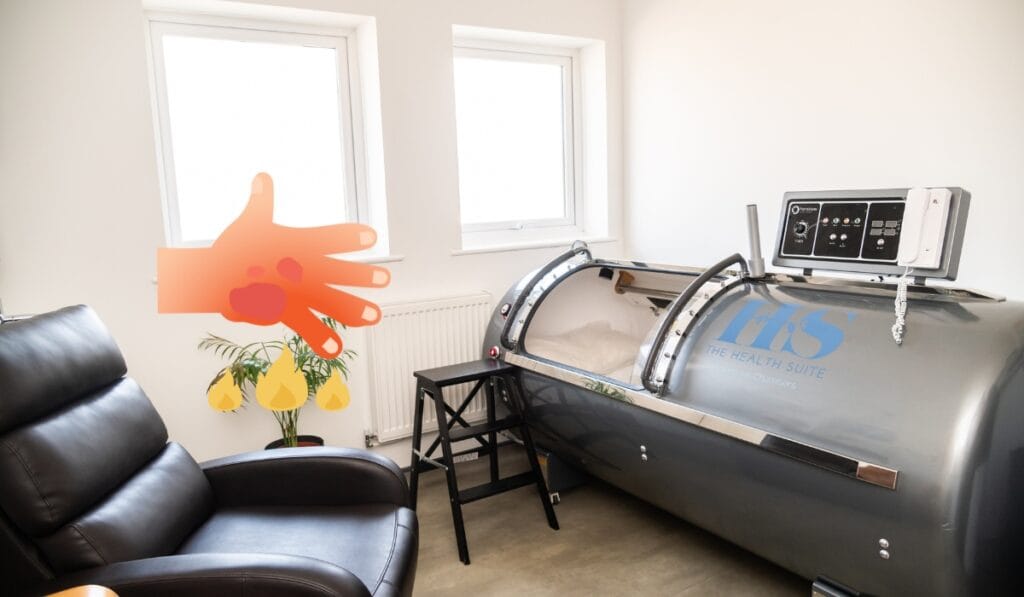Hyperbaric Oxygen Therapy (HBOT) involves breathing 100% oxygen within a pressurised chamber, which enhances oxygen absorption into the bloodstream due to the increased pressure. Traditionally used for conditions like decompression sickness, HBOT is now gaining popularity for treating a variety of other conditions, including burn injuries.
The Devastating Impact of Burn Injuries
Burn injuries are among the most severe and painful forms of trauma, often necessitating prolonged hospital stays, complex wound care, and extensive rehabilitation. Traditional treatments include wound cleaning, debridement, skin grafting, and the use of topical agents. Burn injuries are complex because they affect both the area directly burned and the rest of the body. The severity depends on how hot and how long the exposure was. The heat causes cells in the outer and deeper skin layers to clump together, forming a core area of severe damage. This core is surrounded by zones where blood vessels are damaged, tissues are injured, and fluids leak out.
The Challenges in Healing Burns
Burns cause a lot of inflammation and swelling because the blood vessels expand and leak fluid. The body sends immune cells to the injury, which increases the inflammation. Damaged skin and a weakened immune system increase the risk of infection, and blocked blood vessels make it harder for the burn to heal.
Treating burns effectively involves stabilising the patient’s condition by reducing swelling, saving healthy tissue, and replacing lost fluids. The healing process includes forming new blood vessels, collagen, and cells to repair damaged tissues. Maintaining balance in the body is essential for successful wound healing.
The Role of Hyperbaric Oxygen Therapy (HBOT) in Treating Burn Injuries
Since its first noted use for burns in 1965, HBOT has proven to be effective in treating burn injuries by increasing oxygen levels in damaged tissues, reducing swelling, and promoting faster recovery. Here are some key benefits of HBOT in burn treatment:
- Reduces Swelling: Hyperbaric oxygen therapy (HBOT) helps reduce swelling by narrowing small blood vessels, which decreases fluid leakage. Read more about Inflammation and Hyperbaric Oxygen Therapy.
- Improves Oxygenation: Increased oxygen levels in tissues help preserve damaged areas, alleviating ischemic and hypoxic conditions.
- Enhances Blood Flow: HBOT improves overall circulation and prevents blood cell clumping by inhibiting platelet and neutrophil adhesion.
- Fights Infection: High oxygen levels help kill bacteria and activate immune cells, promoting free radical formation and combating infection.
- Supports Healing: HBOT aids in angiogenesis, collagen formation, and graft survival, promoting new blood vessel growth and overall tissue repair.
HBOT is most effective when initiated within six hours of injury. Treatment typically involves breathing 100% oxygen at increased pressure for up to two hours, twice daily, until improvement is observed. Integrating HBOT with standard burn treatments significantly enhances recovery, offering a promising option for those suffering from severe burns.
Conclusion
In summary, HBOT presents a valuable addition to the arsenal of burn treatment methods, providing benefits that can lead to quicker and more effective healing. As more studies and clinical experiences highlight its advantages, HBOT may become a standard component of burn care protocols.
Click here to learn more about Hyperbaric Oxygen Therapy and book an appointment.
References
- Bhutani, S. & Vishwanath, G. 2012, “Hyperbaric oxygen and wound healing”, Indian Journal of Plastic Surgery, vol. 45, no. 02, pp. 316-324.
- Chong, S.J., Kan, E.M., Song, C., Soh, C.R. & Lu, J. 2013a, “Characterization of early thermal burns and the effects of hyperbaric oxygen treatment: a pilot study”, Diving Hyperb Med, vol. 43, no. 3, pp. 157-161.
- Chong, S.J., Kan, E.M., Song, C., Soh, C.R. & Lu, J. 2013b, “Characterization of early thermal burns and the effects of hyperbaric oxygen treatment: a pilot study”, Diving Hyperb Med, vol. 43, no. 3, pp. 157-161.
- Gill, A.á & Bell, C.N. 2004, “Hyperbaric oxygen: its uses, mechanisms of action and outcomes”, Qjm, vol. 97, no. 7, pp. 385-395.
- Gupta, M. & Somasundaram, I. (2024) Hyperbaric Oxygen Therapy : Principles and Applications. 1st ed. Singapore: Springer Singapore Pte. Limited.
- RONALD P GRUBER, C., BRINKLEY, F.B., JOSEPH J AMATO, M. & JANICE A MENDELSON, L. 1970, “Hyperbaric oxygen and pedicle flaps, skin grafts, and burns”, Plastic and Reconstructive Surgery, vol. 45, no. 1, pp. 24-30.
- Smolle, C., Lindenmann, J., Kamolz, L. & Smolle-Juettner, F. 2021, “The history and development of hyperbaric oxygenation (HBO) in thermal burn injury”, Medicina, vol. 57, no. 1, pp. 49.
- Villanueva, E., Bennett, M.H., Wasiak, J. & Lehm, J.P. 2004, “Hyperbaric oxygen therapy for thermal burns”, Cochrane Database of Systematic Reviews, , no. 2.
Hyperbaric Oxygen Therapy (HBOT) is a medical treatment that entails breathing pure oxygen in a specially pressurised chamber, which enhances oxygen delivery to tissues, facilitating healing and reducing inflammation.

